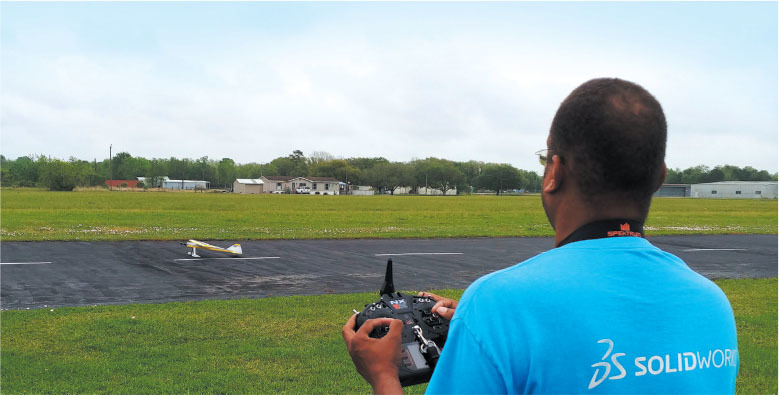Review
Spektrum NX10SE Special Edition 10-Channel DSMX Transmitter
At a Glance
Specifications
Number of channels: 10 Modulation: DSMX/DSM2 Band: 2.4 GHz (RC and Wi-Fi) Model memory: 250 Modes: User-selectable modes 1-4 Transmitter battery type: 3.7-volt, 6,000 mAh Li-Ion Charger: USB Weight: 30.6 ounces (867 grams)Pluses
- More features than you can shake a transmitter at.
- Color display screen.
- Expert-class gimbals.
- Customizable extras.
Minuses
- Throttle ratchet would not engage.
Manufacturer/Distributor
Horizon Hobby (800) 338-4639 www.horizonhobby.com Spektrum RC www.spektrumrc.com SPEKTRUM PIONEERED the use of 2.4 GHz spread spectrum technology for RC models. Although the concept of frequency hopping in a coordinated fashion dates at least to World War II, it wasn’t until the early 2000s that it became a commercially viable product for the RC hobby. Since that time, there has been a constant stream of improvements in both radio transmitters and receivers. Spektrum recently introduced the NX series of radios that appears to be replacing the venerable DX series with more advanced features and usability. For some time now, I’ve had an NX6 and I have quite liked it, but for many of my models, six channels simply aren’t enough. With the NX10, not only do you get four extra channels but also some significant upgrades in both hardware and software functionality. NX6, NX8, and NX10 (six, eight, and 10 channels, respectively) models were released in the last year or so. Spektrum hasn’t been idle, because the company has introduced the NX10SE (presumably the SE stands for Special Edition). This takes the impressive NX10 and adds a few key differences. Let’s see what they are.The Box and Out of the Box
Before I jump to the transmitter, I must mention the SE’s included carrying case. It’s made of some sort of durable, rubberized gray foam. There are two small latches and a carrying handle on the top. The unit has a clamshell-like hinge assembly and features numerous pockets of varying sizes inside for all of the extras that are included with the SE model.Image

Image

Image

Image

Image

Image

Image

Image

Image

Image

Image

Image

Advanced Features
The specifications state that there are 14 programmable mixes, but there are also two more preset mixes for 16 total. I’ve been known to max out mixing on lesser-channel radios in my crazy schemes, so all of that mixing ability gave me a warm, fuzzy feeling. Then there are the built-in sequencers. Yes, you can set up individual servos for sequencing things such as landing gear doors for aircraft with intricate retract systems. There is also a user-configurable preflight checklist. This is a list of items you create and each must be manually acknowledged before the transmitter will allow you to fly. Each model memory can have its own unique checklist. It is quite useful for complicated aircraft. A multitude of audio events (including speech and vibration) are configurable for things as simple as flipping a switch or as advanced as flight-mode changes or telemetry alerts. Additional features of note are a serial interface that supports head-tracking FPV, custom sounds, and even a game controller mode through the USB port. Wi-Fi connectivity (2.4 GHz only) is built in for registration and firmware updates. The NX10SE has separate modes for aircraft, helicopters, gliders, and multirotors. A whopping six swashplate types are supported for helicopters, while glider modes have presets for things such as camber and various wing and tail types. A servo speed menu lets you adjust servo movement from normal to a colossal 720 seconds (although the speed settings become fairly coarse after 40 seconds). That’s up to 12 minutes to move a servo full range. An adjustable servo balance system allows you to fine-tune multiple servos on the same control surface or fine-tune throttle control on multi-engine aircraft. Of course, there is telemetry that supports all sorts of information, from battery voltage and motor rpm to altitude and variometer data.Image

Image

Image

Image

Image

Practical Use
It’s easy to become mired down in all of the technical specifications, but practical usage is ultimately what matters. Setting up a model is straightforward with mostly intuitive menu systems. Although some options are several levels deep in the menu system, their locations are generally logical. Even without reading the manual, spending some time navigating the menu system will reveal it to be mostly self-explanatory, although some options will appear and disappear, depending on the model type and configuration. Being able to copy and load profiles from the SD card (or even the USB port) comes in handy. For most of the models sold by Horizon Hobby and Tower Hobbies, there are company-made configuration files that are either prebuilt into the transmitter’s memory or can be downloaded from the company’s website (or copied from a friend). This was quite handy when it came to setting up models such as the Ultra Stick .60, which can have a complicated mixture of flaps, crow, and 3D modes. All are easy to set up by simply downloading the setup files and importing them into the transmitter.Image

Conclusion
Flying with the NX10SE is great. I could easily adjust the stick lengths and gimbals to my liking. The transmitter is lightweight enough to fly comfortably without a neck strap (although it does include one). My only minor complaint was that the two rear sliders, while convenient, can be tricky to use if you are a stick "pincher" and don’t like to take your hands off the sticks. I’m impressed with the radio’s number of features and flexibility in programming. It’s not just the utility of having 10 channels but also the extra capabilities within the software. Add to that the high-tech gimbals, sturdy carrying case, and color customization and you have a highly capable radio system that will last you a long time.By Fitz Walker | [email protected]Photos by the author










Comments
custom sounds not yet supported
My DX9 supports custom sound files. The NX radios as of late 2023 do not.
Add new comment